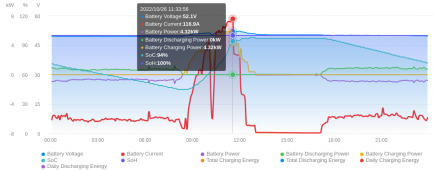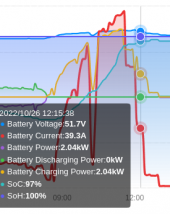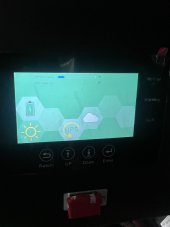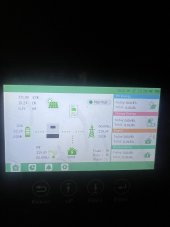Most batteries support the pylontech protocol, which the luxpower inverter also supportsLuxpower compatible battery available locally is the new EG4-LL V2:
RS485: P01-EG4 EG4, P02-GRW Growatt, P03-LUX Luxpower, P04-SCH Schneider
CAN: P01-GRW Growatt, P02-SLK Sol-Ark, P03-DY Deye, P04-MGR Megarevo, P05-VCT Victron, P06-LUX Luxpower
I scanned the other EG4 batteries manual and I didn't find the same protocol settings for them. EG4 is planning on a firmware update for the version 1 batteries. You need to do your own due diligence for the other EG4 batteries to determine, if they are compatible or will be compatible with the Luxpower inverters.
You are using an out of date browser. It may not display this or other websites correctly.
You should upgrade or use an alternative browser.
You should upgrade or use an alternative browser.
New Lux Power LXP-LB-US 12k / GSL-H-12KLV-US with 200A AC Passthrough Current (US Market)
- Thread starter adamantium
- Start date
- Status
- Not open for further replies.
Not Aerosmith
Solar Enthusiast
- Joined
- Sep 8, 2022
- Messages
- 389
I will now have a beta version of the new GSL-12K hybrid inverters and a newly release version 2 of EG4-LL batteries. Sounds like a formula for a disaster or at best a nightmare. EG4 will blame all the problems on GSL and vice versus.
Not Aerosmith
Solar Enthusiast
- Joined
- Sep 8, 2022
- Messages
- 389
Good to know. The other batteries compatibility list didn't include Luxpower, so I looked until I found a battery available locally that did. I'm sure you are right and I wasted my time. I have never bought a solar battery. I have been told that not all batteries and all inverters are compatible, and GSL stated that the battery needs to be compatible. If I looked foolish in this quest for a battery, enjoy the laugh. I would rather look foolish than spend thousand of dollars on batteries plus shipping to Panama and discover they don't work.Most batteries support the pylontech protocol, which the luxpower inverter also supports
Last edited:
I can appreciate the over charge concern. My plan is to operate between 25~75% SOC, 51.4~53.1. Sure I don't get to use the whole capacity but figure it's safer to add more battery than to push the edges. But I haven't thought to confirm these inverters battery measurement precision and accuracy. Thanks for the headup. This forum really rocks, learning new stuff daily
Not Aerosmith
Solar Enthusiast
- Joined
- Sep 8, 2022
- Messages
- 389
I intended to do something very similar, but in my search about batteries I found some some information on SOC%:
Common cells such as the NiCoAl (NCA) cells used in common EV’s are subjected to increased stresses when above 90% SOC that due to their construction, LFP cells are not.
There is a lot more information on this site about batteries and Solar Assistant. I intend to try and digest all the information before I receive my batteries:

 www.currentconnected.com
www.currentconnected.com
Charging SOC%
A common misconception about LiFePO4 (LFP) is that it is best to operate in the 30%~90% SOC region, however this applies to every other lithium based chemistry except for LFP. If you only charged these batteries to 90%, then the BMS would never have a chance to offer any cell balancing due to the stable nature of LFP’s charge curve. If cells get out of balance, then the capacity of the entire pack is reduced to the capacity between the fully-discharged voltage of the lowest cell and the fully-charged voltage of the highest cell. If packs are not regularly balanced by the BMS, then the difference in balance can easily overcome what the BMS is able to correct, leading to quite poor performance of the system in general.Common cells such as the NiCoAl (NCA) cells used in common EV’s are subjected to increased stresses when above 90% SOC that due to their construction, LFP cells are not.
There is a lot more information on this site about batteries and Solar Assistant. I intend to try and digest all the information before I receive my batteries:

SK48V100 Server Rack Battery Owner & Operator's Manual | Current Connected
Full instruction manual for the SOK SK48V100 server rack battery. Everything you need to know is contained within this document!
Not Aerosmith
Solar Enthusiast
- Joined
- Sep 8, 2022
- Messages
- 389
See above for my comments, I forgot to hit reply in the above post.I can appreciate the over charge concern. My plan is to operate between 25~75% SOC, 51.4~53.1. Sure I don't get to use the whole capacity but figure it's safer to add more battery than to push the edges. But I haven't thought to confirm these inverters battery measurement precision and accuracy. Thanks for the headup. This forum really rocks, learning new stuff daily
I found a battery that has both choices for Canbus or RS485 protocol for LUX, which are for Luxpower inverters. I'm not using some generic protocol setting for all lithium type batteries that I need to manually adjust per the manufacturer's recommendations. Hopefully, these settings under LUX are already per the actual manufacturer recommendations for values and ranges. If I ever get more knowledgeable about batteries, I can then tweak the settings.
Last edited:
fromport
Solar Addict
If you want to go for longevity with your lifepo4 it is better to limit your discharge to 20% -> 100% down to 20% and back up.I intended to do something very similar, but in my search about batteries I found some some information on SOC%:
Charging SOC%
A common misconception about LiFePO4 (LFP) is that it is best to operate in the 30%~90% SOC region, however this applies to every other lithium based chemistry except for LFP. If you only charged these batteries to 90%, then the BMS would never have a chance to offer any cell balancing due to the stable nature of LFP’s charge curve. If cells get out of balance, then the capacity of the entire pack is reduced to the capacity between the fully-discharged voltage of the lowest cell and the fully-charged voltage of the highest cell. If packs are not regularly balanced by the BMS, then the difference in balance can easily overcome what the BMS is able to correct, leading to quite poor performance of the system in general.
Common cells such as the NiCoAl (NCA) cells used in common EV’s are subjected to increased stresses when above 90% SOC that due to their construction, LFP cells are not.
There is a lot more information on this site about batteries and Solar Assistant. I intend to try digest all the information before I receive my batteries:

SK48V100 Server Rack Battery Owner & Operator's Manual | Current Connected
Full instruction manual for the SOK SK48V100 server rack battery. Everything you need to know is contained within this document!www.currentconnected.com
With my megarevo I clearly see the BMS and inverter communicating to taper off charging current close to being full:

top charging rate at my battery pack up to 95%
After that it tapers down

Up to 98% charged

I dont't see problems with it being charged to nearly full every day this way
Not Aerosmith
Solar Enthusiast
- Joined
- Sep 8, 2022
- Messages
- 389
If you want to go for longevity with your lifepo4 it is better to limit your discharge to 20% -> 100% down to 20% and back up.
With my megarevo I clearly see the BMS and inverter communicating to taper off charging current close to being full:
I dont't see problems with it being charged to nearly full every day this way
Your graphs are impressive. Are these graphs from Solar Assistant or from Deye software? I understand that Deye is the actual manufacturer of the megarevo inverters.
I think what you are saying is in total agreement with the battery manufacturer's recommendation. The recommendation was based on the higher end to let the BMS balance the cells, which is the same as yours. The battery manufacturer didn't actually make a recommendation for the lower value, so there is no dispute about the 20% value. The manufacturer only showed the misconception range of 30%-90% as not being ideal for LFP batteries.
I'm definitely struggling in trying to learn about solar energy. DIY Solar Forum has been a great resource and you have been my most valuable mentor.
fromport
Solar Addict
From a company that makes the WIFI dongles attached to a lot of inverters: https://pro.solarmanpv.com/Your graphs are impressive. Are these graphs from Solar Assistant or from Deye software?
I thought so too in the beginning but I think that is not the caseI understand that Deye is the actual manufacturer of the megarevo inverters.
Imo, the best to trace the source is the UL certification.
From the GSL UL Certification:
Applicant: Shenzhen GSL Energy Co., Ltd.
Manufacturer: Shenzhen Sea Star Industry Co., Ltd
That is the only company that can get a UL cert.
luxpower/GSL/liniotech are imo just resellers.
Now we have to find the UL cert that mentions the manufacturer for deye ;-)
Not Aerosmith
Solar Enthusiast
- Joined
- Sep 8, 2022
- Messages
- 389
In the GSL manual, I noticed that the app to use by smartphone is by Luxpower:That is the only company that can get a UL cert.
luxpower/GSL/liniotech are imo just resellers.
3.10.1 Wifi/GPRS/4G/WLAN dongle connection
Users can use WiFi/ WLAN /4G /2G dongle to monitor their inverter, and view the monitoring data on computer or
smart phone remotely.
To view data on smartphone, please download the LuxPowerView APP from Google Play or Apple APP store, then login
with their user account.
Not sure that means anything.
Sol Ark 15K is made by Deye, so perhaps the information is available on the UL certificate for SA-15K. If you can find a Deye inverter with a UL Listing, you can view the actual certificate on Alibaba. They are good about providing all information on companies with copies of all their certifications.
Last edited:
Not Aerosmith
Solar Enthusiast
- Joined
- Sep 8, 2022
- Messages
- 389
Luxpower_Gilbert
Luxpert @Luxpower USA Team
It depends on how the pack is utilized. For daily consumption, charging fully makes sense as the pack won't spend too much time above 80%. Permanent deterioration starts around 80%, worsen with high temperature. Perhaps the ideal profile is to fully charge on a regular schedule, say weekly/biweekly/monthly. My immediate application is UPS backup, so the pack is not utilized 90% of the time.If you only charged these batteries to 90%, then the BMS would never have a chance to offer any cell balancing due to the stable nature of LFP’s charge curve. If cells get out of balance, then the capacity of the entire pack is reduced to the capacity between the fully-discharged voltage of the lowest cell and the fully-charged voltage of the highest cell. If packs are not regularly balanced by the BMS
Not Aerosmith
Solar Enthusiast
- Joined
- Sep 8, 2022
- Messages
- 389
629+292=921W Is the missing 21W inverter consumption or batteries losses? I have a similar flow diagram but the flows are balanced. However, I don't have batteries connected to my existing GT system.I got another update..
Values on the right looks fine, since there is no PV energy, charge energy or export. However, there is consumption, so why is it also zero instead of 900W? Makes me wonder, if you had PV energy, charge energy or export would they still be shown as zero or would they have the correct values?
I understood that you were going to save your batteries for peak shaving, so is it suppose to be discharging now?
How many firmware updates have your received? When you get a new firmware update, do you need to check your manual input settings to make sure nothing was changed by the firmware?
Last edited:
Luxpower_Gilbert
Luxpert @Luxpower USA Team
Yes, when load is off 21-23 watts ac if im not mistaken about 37-39watts dc…629+292=921W Is the missing 21W inverter consumption or batteries losses? I have a similar flow diagram but the flows are balanced. However, I don't have batteries connected to my existing GT system.
Values on the right looks fine, since there is no PV energy, charge energy or export. However, there is consumption, so why is it also zero instead of 900W? Makes me wonder, if you had PV energy, charge energy or export would they still be shown as zero or would they have the correct values?
I understood that you were going to save your batteries for peak shaving, so is it suppose to be discharging now?
How many firmware updates have your received? When you get a new firmware update, do you need to check your manual input settings to make sure nothing was changed by the firmware?
adamantium
Solar Enthusiast
- Joined
- Jul 17, 2022
- Messages
- 172
That's good. Now Californians need not fret.Interesting... I see the LXP-LB-US 12K showed up on the CEC equipment list recently. No sign of GSL or Shenzen Sea Star though.
I don't think you will see Shenzen Sea Star on the list. They are an Electronics Manufacturing Services (EMS) company not an Original Equipment Manufacturer (OEM). Since this distinction can be a little confusing, let me use an example to explain it. Apple Computer makes iPhones right? Right! That means they manufacture iPhones right? Wrong! They don't manufacture iPhones. They hire other companies to manufacture iPhones. These companies are called Electronics Manufacturing Services (EMS) companies or Electronic Contracts Manufacturing (ECM) companies, and they manufacture many products for many companies. That's their business. So in this example, Apple is the designer and the brand for the iPhone, but FoxConn is one of Apple's largest ESM/ECM companies. Foxconn specializes in the manufacturing of smartphones, PCs, servers, power supplies, and connectors. In addition to Apple, its top 5 customers include Dell, HP Inc., Samsung, and LG.
So with this inverter, Lux Power is the designer and the brand, and Shenzen Sea Star is the manufacturer or the EMS company. GSL is a rebrander of the Lux Power brand and probably has a business relationship with Lux Power not Shenzen Sea Star company.
What does this have to do with the UL certification? UL certifications are granted to the companies that pay for the certification. EMS companies not only provide manufacturing services, but they also can provide other services like supply chain, marketing, testing, support and repair, etc. In this case they must have provided the UL certification for Lux Power.
Here is more information about ESMs and Shenzen Sea Star.
So it is the Luxpower LXP-LB-US 12K that made it onto the CEC List, correct?That's good. Now Californians need not fret.
I don't think you will see Shenzen Sea Star on the list. They are an Electronics Manufacturing Services (EMS) company not an Original Equipment Manufacturer (OEM). Since this distinction can be a little confusing, let me use an example to explain it. Apple Computer makes iPhones right? Right! That means they manufacture iPhones right? Wrong! They don't manufacture iPhones. They hire other companies to manufacture iPhones. These companies are called Electronics Manufacturing Services (EMS) companies or Electronic Contracts Manufacturing (ECM) companies, and they manufacture many products for many companies. That's their business. So in this example, Apple is the designer and the brand for the iPhone, but FoxConn is one of Apple's largest ESM/ECM companies. Foxconn specializes in the manufacturing of smartphones, PCs, servers, power supplies, and connectors. In addition to Apple, its top 5 customers include Dell, HP Inc., Samsung, and LG.
So with this inverter, Lux Power is the designer and the brand, and Shenzen Sea Star is the manufacturer or the EMS company. GSL is a rebrander of the Lux Power brand and probably has a business relationship with Lux Power not Shenzen Sea Star company.
What does this have to do with the UL certification? UL certifications are granted to the companies that pay for the certification. EMS companies not only provide manufacturing services, but they also can provide other services like supply chain, marketing, testing, support and repair, etc. In this case they must have provided the UL certification for Lux Power.
Here is more information about ESMs and Shenzen Sea Star.
That’s a significant achievement and pretty much a confirmation of where the technical expertise behind the design comes from.
With all of this talk about new firmware releases, do we have any indication of where that firmware is actually being developed / coming from?
It’s still very early days and I don’t need anything close to 12kW of power, but if things settle down over the next year and we see the LXP-LB-US 12K establish itself as a Solark-like alternative offering Solark-like performance and Solark-like maturity at a fraction of the cost of a Solark, that’s going to be an option I’d be crazy not to consider….
adamantium
Solar Enthusiast
- Joined
- Jul 17, 2022
- Messages
- 172
Yes the manufacturer it is listed under is Shenzhen Lux Power Technology Co., Ltd.So it is the Luxpower LXP-LB-US 12K that made it onto the CEC List, correct?
That’s a significant achievement and pretty much a confirmation of where the technical expertise behind the design comes from.
With all of this talk about new firmware releases, do we have any indication of where that firmware is actually being developed / coming from?
It’s still very early days and I don’t need anything close to 12kW of power, but if things settle down over the next year and we see the LXP-LB-US 12K establish itself as a Solark-like alternative offering Solark-like performance and Solark-like maturity at a fraction of the cost of a Solark, that’s going to be an option I’d be crazy not to consider….

I have been wondering where the firmware is being developed too. Maybe GSL is tweaking Lux Power's software, or maybe GSL is writing it for Lux Power, or maybe GSL is delegating all work to a Lux Power team that does all of the software for them. Who knows? I don't.
adamantium
Solar Enthusiast
- Joined
- Jul 17, 2022
- Messages
- 172
Note above that California has a definition for grid support inverters and hybrid inverters.
- Status
- Not open for further replies.
Similar threads
- Replies
- 7
- Views
- 503
- Replies
- 54
- Views
- 2K






